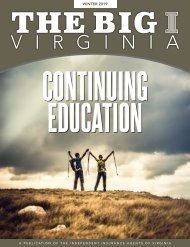The Big I Virginia Winter 2022-23
Create successful ePaper yourself
Turn your PDF publications into a flip-book with our unique Google optimized e-Paper software.
percentage of jobs that are conducive to remote work <strong>The</strong>se labor market changes during the Great Reshuffle<br />
are<br />
Introduction<br />
now being done remotely and many workers and will continue to impact workers compensation frequency.<br />
employers have embraced this flexibility. Remote work But any further ripples are expected to come from smaller<br />
<strong>The</strong> Great Reshuffle is reshaping the US labor market. Unemployment is historically low, but labor force<br />
will continue to be important to office and clerical sectors, year-to-year labor market changes than what we have<br />
as some participation firms continue is still to lower expand than remote the pre-pandemic or hybrid-work rate. Labor already shortages seen and have are led unlikely to wage to have growth, major especially effects on<br />
options strong and among others low-wage return to the workers office. and It will in be sectors important like Leisure long-term and Hospitality. frequency trends.<br />
to obtain better estimates of the relative risk of remote and<br />
on-site Quit workers rates jumped as employees, in the middle firms, and of 2021 insurers and get remain used high at the time of this writing—about 50 million quits a<br />
to remote year, almost work. 10 million more than pre-pandemic averages. Many workers are new to their jobs. Some of these<br />
are moving from one similar job to another, but others are changing industries or occupations. At the same<br />
time, there are a large number of new remote workers. Many people left the office at COVID’s onset; there has<br />
been a trickle back, representing a massive change in the amount of remote work compared to before the<br />
pandemic. ACKNOWLEDGEMENTS<br />
<strong>The</strong> author would like to thank Len Herk, Carolyn Wise, Shawn Adcock, Kevin Fernes, Francesco Renna, and<br />
How Barry do Lipton such for large important changes contributions in the labor to market this study. impact workers compensation injury frequency? <strong>The</strong> magnitude<br />
of these impacts relies on the interaction of three factors:<br />
• How much more or less likely are short-tenured or remote workers to be injured than other workers?<br />
• How much has the share of such workers changed?<br />
• How has the sector mix of the workforce changed during the pandemic?<br />
ENDNOTES<br />
1<br />
We show this series from 1996 through 2018 in How Do Recessions Affect Workers Compensation? NCCI, October 16, 2019.<br />
2<br />
We discuss this for the case of auto manufacturing in our Supply Chain Disruptions and <strong>The</strong>ir Employment Impacts, With Case Studies for<br />
Residential Construction and Auto Manufacturing, NCCI, December 13, 2021.<br />
3<br />
Data based on the January <strong>2022</strong> survey will be released later this year (<strong>2022</strong>), but even then we will need to rely on estimates created in part<br />
from other sources, as there will be no direct data on the share of short-tenured workers between January 2020 and <strong>2022</strong>.<br />
4<br />
In this brief, we use the term “full-tenured” to mean all workers with at least one year at their current employer – the opposite of short-tenured.<br />
5<br />
<strong>The</strong> relative risks reported here are calculated from 2018 worker shares and injuries by tenure. We did similar calculations for each year from<br />
2011–2020 and found broadly similar relative risks across the whole period in terms of magnitudes and also differentials between different<br />
sectors.<br />
6<br />
We also collect hours worked from the CPS microdata, downloaded from IPUMS-CPS, to put worker shares in terms of full- time equivalent<br />
(FTE) workers. This is an important adjustment because short-tenured workers are more likely than full- tenured workers to work part-time.<br />
7<br />
This is in sharp contrast to retail sales workers, who have the second-highest concentration of short-tenured workers of any sector, behind<br />
only Leisure and Hospitality.<br />
8<br />
An in-depth discussion of how remote workers are defined and measured can be found in Remote Work Before, During, and After the<br />
Pandemic, NCCI, January 25, 2021.<br />
9<br />
This is calculated from a COVID-19 Supplement to the Current Population Survey.<br />
10<br />
COVID-19 Pandemic Continues to Reshape Work in America, February 16, <strong>2022</strong>, Pew Research Center.<br />
11<br />
Remote Work Persisting and Trending Permanent, October 13, 2021, Gallup.<br />
12<br />
Part-time workers are more likely to have jobs that require in-person work in sectors such as Leisure and Hospitality or Retail Trade.<br />
13<br />
Telecommuting and Workers Compensation: What We Know, NCCI, January 25, 2021.<br />
14<br />
Specifically, we exclude “exposure to harmful substances and environment” cases in all years as a proxy for COVID-19 cases. This category<br />
was responsible for only about 4 cases per 10,000 FTE workers in each year from 2011–2019, but 43.5 cases per 10,000 workers in 2020.<br />
15<br />
<strong>The</strong>re is slight upward pressure on frequency between 2020 and 2021 from a partial return to office of 2020 remote workers, but since Leisure<br />
and Hospitality has a high degree of in-person work and a low share of remote workers, the impact is small. This sector scenario is primarily<br />
about short-tenured worker shares.<br />
16<br />
As for Leisure and Hospitality, the 2020 to 2021 change also reflects minor impacts from the changing share of remote workers.<br />
17<br />
We break down pre-pandemic employment by state in our 2019 Q4 Quarterly Economics Briefing, Employment and Wage Growth by State<br />
and Economic Sector, NCCI, January 9, 2020.<br />
18<br />
NCCI primarily uses frequency per premium in ratemaking, but frequency is also calculated per payroll or per worker. <strong>The</strong> choice of frequency<br />
metric and differences between the various measures are discussed at length in NCCI Explains Its Top 3 Frequency Measures, NCCI, October<br />
15, 2018.<br />
WINTER <strong>2022</strong>-<strong>23</strong> THE BIG I VIRGINIA <strong>23</strong>

















